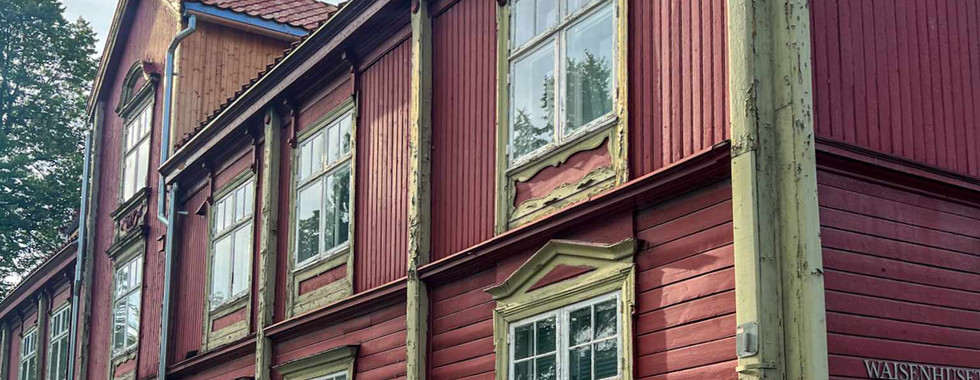(10)Day Ten: Exploring Trondheim – Bridges, Cathedral, Bakklandet, and Cycling Adventures
- Elflilja
- Sep 15, 2024
- 6 min read
Updated: Oct 9, 2024
As tired as we were from the previous day's adventures and as much as we wanted to avoid large cities, the allure of Trondheim was irresistible. The distance wasn’t severe, so we set out on foot toward the city center.
Norway’s third-largest city, Trondheim, quickly won us over with its calm and livability – in contrast to the exciting but crowded Ålesund, this city somehow seemed friendlier.

According to the map, our first stop was the Elgeseter bru, Trondheim’s busiest bridge. Standing on it, we could indeed feel the city’s pulse, and we eagerly anticipated moving on to uncover Trondheim’s secrets. The famous Nidaros Cathedral was just a stone’s throw from Elgeseter bru, and it was part of our plan to see it.
This imposing building is not just Trondheim’s pride but Norway’s as well. Construction began around 1070, following the death of King Olaf II Haraldsson (Saint Olaf), who was Norway's king that introduced Christianity. After his death, his grave became a primary Christian pilgrimage site. Imagine our luck arriving on the very day the city was celebrating Saint Olaf’s Days (Olsok-dagene) – the most significant event drawing a series of religious and cultural programs. The festivities last for weeks, filled with pilgrimages, concerts, theatrical performances, and much more.
After soaking in the cathedral’s impact and taking numerous photos, we moved on and found the Gamle Bybro (Old Town Bridge). This bridge spans the Nidelva River and, as one of the city’s icons, has a close connection with the charming Bakklandet neighborhood. The sight of the colorful, old warehouse buildings and Gamle Bybro with its gates was particularly captivating. The bridge is popularly known as "Lykkens portal" (The Gate of Happiness).
With a little walk, we reached Bakklandet, which felt like a Scandinavian version of Szentendre, only larger and more orderly. The houses were colorful, the streets were clean, and the bike lanes were exemplary.
But Bakklandet is not only special for its cycling infrastructure but also for the Trampe Bike Lift. The world’s first bike lift opened in 1993, but it was redesigned in 2012 to help cyclists on the steep Brubakken street. The lift works so cleverly that it doesn’t actually pull the bike but requires the cyclist to hook their foot into the lift while the moving platform pushes them up the hill. Such a unique invention!
As time passed, our feet began to tire, and by the end of the day, we retreated to our accommodation. On the way, we stopped by a store that was supposed to be open longer than when we arrived (could it be because of St. Olaf's Day), but the shopkeeper at the entrance informed us it would be open for just 2 more minutes. We only needed 2 things, so that was enough. Since there were self-service checkouts everywhere, it only became noticeable when leaving that there was only one person in the whole store. As we walked past the store, the shopkeeper came out and went home. It’s interesting how the store system is as automated as other parts of the city!
After all this, we settled into bed on our last night in Norway, content with our exploration of this unique city. Trondheim’s history and character are truly captivating – the city sets an example not only with its past but also with its current cycling culture. For me, it's the perfect cycling city! Maybe one day we’ll uncover even more details, but until then, Trondheim, thank you for everything!
The History of Trondheim:
One of Norway’s oldest and historically significant cities, deeply rooted in the country’s religious, cultural, and political history. The city was founded in 997 and was originally known as Kaupangen, derived from an Old Norse word meaning "marketplace" or "trading place." Later, it became known as Trondheim and then Nidaros, reflecting the city’s religious and spiritual importance, as it became Norway’s Christian center during the Middle Ages.
Trondheim played a crucial role in Norway’s conversion to Christianity. Saint Olaf, the Norwegian king who was canonized for spreading Christianity, died here at the Battle of Stiklestad in 1030. After his death, he was venerated as a saint, and his grave made Trondheim a pilgrimage site. The cathedral became the coronation site for Norwegian kings and the city served as Norway’s religious center for a long time. During the Middle Ages, Trondheim was also used as the country’s capital, especially since royal graves and religious treasures were placed here.
The city was also an important port and trading center during the Viking Age. Its strategic location played a significant role in maritime trade, and the city quickly developed, particularly through shipping and fishing. During the Middle Ages, trade, fishing, and agriculture provided the economic basis for the city.
In the 16th and 17th centuries, it fell under Danish and Swedish rule during Scandinavian power struggles. This period was challenging for the city, including wars, plague outbreaks, and fires. One of the biggest fires in 1681 destroyed much of the city, leading to a new urban plan with wider streets and more modern buildings.
In the 19th and 20th centuries, Trondheim transformed from a traditional trading and fishing center into an industrial and educational hub. The establishment of the Norwegian University of Science and Technology (NTNU) made the city one of the country’s leading educational and research centers. Trondheim underwent significant industrial development, especially in the technology and telecommunications sectors.
During World War II, the Germans occupied the city and used it as a strategic naval base. One of the largest German naval bases, the Dora submarine bunker, was built here, still reminding the city of its wartime past. During the occupation, Trondheim was also a significant center of resistance, with the Norwegian resistance movement carrying out many actions in the area.
Today, the city remains one of Norway’s cultural centers, hosting numerous music, art, and cultural festivals annually, such as the mentioned Saint Olaf’s Days (Olsok). The city’s music scene, especially in jazz and classical music, also flourishes.
The History of Nidaros Cathedral:
Nidaros Cathedral is one of Norway’s most important religious and historical buildings, located in the city of Trondheim. The building not only served as the coronation site for Norwegian kings but also played a crucial role in Norway’s Christian history.
Construction began around 1070, after the death of King Olaf II, who was later canonized. After his death, Trondheim was made a Christian pilgrimage site, and the church was built on the site of Saint Olaf’s shrine. The goal of the construction was to make Saint Olaf’s grave the center of Christian culture, and the process took place gradually during the Middle Ages. Initially, the church was in Romanesque style, but later phases of construction included Gothic elements. Construction began in 1152, and the first phase was completed by 1215.
The cathedral served as the center of Norwegian Christianity. During the Middle Ages, it was the coronation site for Norwegian kings and had significant religious importance in Norway’s Christian history. The building suffered greatly during the Reformation, Danish rule, and Swedish wars. In 1537, when Norway came under Danish rule, the church suffered significant damage, with many valuable statues and sacred treasures destroyed.
In the 17th and 18th centuries, the cathedral underwent several reconstructions and restorations. Various parts and elements were restored to return them to their previous states. In the 19th century, significant restoration work began, led by architect Eriksen. His work restored the cathedral to its medieval splendor, and the Gothic elements were reinstated. The architectural and artistic values of the cathedral have become important for the modern era.
Today, Nidaros Cathedral is one of Norway’s most significant tourist attractions, important not only for religious reasons but also for historical and cultural reasons. It is famous for the Golden Gate, a gift from the medieval Danish king, II. Valdemar, and one of the cathedral’s most well-known and beautiful artworks. Nidaros Cathedral plays a crucial role in preserving Norway’s history and heritage through its religious, historical, and artistic values.
The History of Gamle Bybro:
The bridge was originally built in 1681 under the command of Johan Caspar von Cicignon, shortly after the city was devastated by a massive fire. As part of the reconstruction, a new bridge structure was needed to connect Trondheim’s fortifications with the city. The bridge was rebuilt in its current form in 1861 based on designs by Hans Peter Jenssen, featuring two impressive red-colored ornate gates. These gates give the bridge its nickname, "Lykkens portal" (The Gate of Fortune), as tradition holds that it brings good luck to those who walk across it. Initially, the bridge played a strategic role in the city’s defense, serving as a key crossing point for monitoring access in and out of the city. Today, it is more of a tourist attraction but remains an important part of Trondheim’s history. It offers a stunning view over the Nidelva River, the old warehouse buildings (Bryggerek), and the Nidaros Cathedral. It has become one of the city’s most romantic spots, where many take photos and enjoy a peaceful walk.
The History of Bakklandet:
Originally home to workers, craftsmen, and merchants during the 17th-18th centuries, this area remained somewhat isolated from central city life for a long time but has now become one of Trondheim’s most popular areas. The colorful wooden buildings, cafes, shops, and galleries create a unique atmosphere. This location is particularly popular among locals and tourists who enjoy the relaxed, bohemian vibe. Bakklandet is also home to the world’s first bicycle lift, which is a unique tourist attraction. It was established to assist cyclists with the steep hill leading to the area.











































































Comments